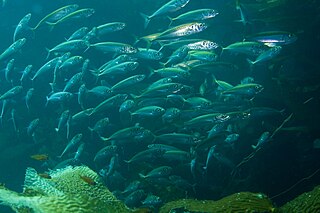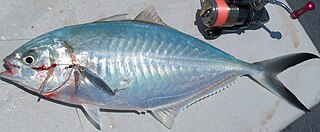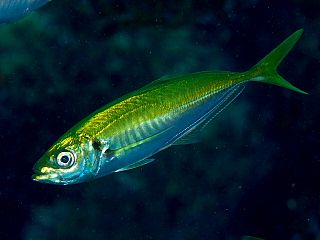
Threadfins are silvery grey perciform fish of the family Polynemidae. Found in tropical to subtropical waters throughout the world, the threadfin family contains eight genera and about 40 species. An unrelated species sometimes known by the name threadfin, Alectis indicus, is properly the Indian threadfish.

The Carangidae are a family of ray-finned fish which includes the jacks, pompanos, jack mackerels, runners, and scads. It is the largest of the six families included within the order Carangiformes. Some authorities classify it as the only family within that order but molecular and anatomical studies indicate that there is a close relationship between this family and the five former Perciform families which make up the Carangiformes.

The Pacific jack mackerel, also known as the Californian jack mackerel or simply jack mackerel, is an abundant species of pelagic marine fish in the jack family, Carangidae. The species is distributed along the western coast of North America, ranging from Alaska in the north to the Gulf of California in the south, inhabiting both offshore and inshore environments. The Pacific jack mackerel is a moderately large fish, growing to a maximum recorded length of 81 cm, although commonly seen below 55 cm. It is very similar in appearance to other members of its genus, Trachurus, especially Trachurus murphyi, which was once thought to be a subspecies of T. symmetricus, and inhabits waters further south. Pacific jack mackerel travel in large schools, ranging up to 600 miles offshore and to depths of 400 m, generally moving through the upper part of the water column.

Caranginae is a subfamily of ray-finned fish from the family Carangidae which consists of twenty genera and 103 species.

The shrimp scad, is a species of widespread tropical marine fish of the jack family, Carangidae. The shrimp scad is widely distributed in the tropical and subtropical western Indian Ocean and areas of the eastern Pacific Ocean, ranging from South Africa in the west to Hawaii in the east, including Japan and Australia to the north and south. The species is commonly found on inshore reefs and sandy substrates. It has the common body profile of a scad, and may be difficult to differentiate from others in the genus Alepes. It is one of the larger scads, growing to 40 cm, but often is encountered at much smaller sizes. The shrimp scad often forms large schools, and is carnivorous, consuming a variety of crustaceans and small fish. It is of moderate importance to fisheries throughout its range.

The blackfin scad is a species of tropical marine fish of the jack family Carangidae. The species inhabits inshore waters throughout the Indo-Pacific region, although is rare in the western Indian Ocean. It is not a large species, with the largest reported capture being 25 cm, and it is distinguished readily from similar species by the prominent black dorsal fin. It is a predator which feeds on planktonic crustaceans, but little else is known of its biology. The blackfin scad is a minor food fish throughout its range, and is highly valued in Cambodia and Thailand.

The razorbelly scad is a small species of tropical marine fish in the jack family, Carangidae. The species inhabits coastal waters in the Indo-Pacific, from Pakistan in the west to Japan and Australia in the east, often found over reefs. The razorbelly scad has a complex taxonomic history, and even recently has had its position in the genus Alepes challenged, but appears to be stable after a molecular phylogeny study supported its placement in Alepes. It is very similar to other scads in the same genus, but is readily identified by its unique teeth. Razorbelly scad are predatory fish, taking a variety of crustaceans and shrimps, and show a change in feeding intensity over the year. Reproduction and development has been extensively studied in India, where spawning occurs in a single event from January to September. The species is commonly taken in tropical fisheries, where it is marketed fresh or dried.

Alepes is a genus containing five extant species of tropical marine fishes in the jack family, Carangidae. They are commonly known as scads, a term applied to many genera of carangid fishes. Their body form, however, differs from these other scads by being much more ovate in shape, more similar to the larger jacks taken as game fish, although scads are generally much smaller. They are found in coastal waters throughout the Indo-West Pacific region.

The herring scad, is a common species of tropical marine fish in the jack family Carangidae. The species inhabits the surface waters of coastal regions throughout the Indo-West Pacific region, feeding on a variety of crustaceans and small fishes. It is the largest fish of the scad genus Alepes, growing to a recorded length of 56 cm. The herring scad is identified among the genus Alepes by its more numerous and smaller scutes and the number of gill rakers on the first arch. It is of minor importance to fisheries throughout its range.

The yellowtail scad, is an abundant species of small inshore marine fish of the jack family, Carangidae. The species is widespread in the Indo-Pacific region from east Africa in the west to Hawaii in the east, extending north to Japan and south to Australia. The yellowtail scad is the only member of the monotypic genus Atule and is distinguished from similar species by a well-developed adipose eyelid and finlet-like extensions of the last rays of the dorsal and anal fins. It inhabits coastal areas such as bays and coral reefs, preying on small fishes and crustaceans. Spawning has been well studied in Hawaii, where fish enter bays to spawn, releasing up to 161,000 eggs each between March and October. The yellowtail scad is an important component of fisheries throughout its range, taken by a number of netting and hook-and-line methods. It is a prized food fish in some regions and is cooked or preserved by a variety of methods.

The mackerel scad, or speedo, is a species of fish of the family, Carangidae. While mackerel scad can be considered gamefish, they are usually used as bait. However, they are popular eating fish in the Hawaiian islands, where they are called `opelu.

The false scad, also known as the spotfin scad, ten-finned horse mackerel and yellow horse mackerel, is a species of medium-sized marine fish classified in the jack family Carangidae. The false scad is distributed throughout the tropical and temperate waters of the eastern Atlantic Ocean from Namibia in the south to Spain and throughout most of the Mediterranean in the north. The species has an atypical body form compared to other species of Caranx, and can be distinguished from these on its elongate 'scad-like' body shape alone. Distinguishing the species from members of Decapterus and Trachurus is more difficult, requiring detailed anatomical analysis. The false scad is known to grow to a length of 60 cm and a weight of 1 kg. The species lives both pelagically and demersally in continental shelf waters, ranging from depths of 15 to 200 m. It is a predatory fish, taking small fishes, crustaceans including euphausiids and shrimps, and cephalopods as its main prey, with significant dietary shifts as it ages. The false scad reaches sexual maturity at 2 years of age, with spawning occurring between April and July in shallow inshore waters, where the juveniles remain. The species is of major importance to fisheries throughout its range, but particularly from Morocco to Senegal, with annual catches ranging from 500 to 19000 t. The species is caught using trawls, seine nets and gill nets and sold fresh, frozen or salted.

The torpedo scad, also known as the hardtail scad, finny scad, finletted mackerel scad or cordyla scad, is a species of moderately large marine fish classified in the jack and horse mackerel family, Carangidae. The torpedo scad is distributed throughout the tropical Indo-Pacific region, ranging from South Africa in the west to Tonga in the east, extending to Japan in the north and Australia in south. It is a schooling pelagic fish which occupies the surface layers of both inshore and offshore oceanic waters. The torpedo scad is easily identified by both its 'torpedo' shaped body and a series of detached finlets at the rear of both the dorsal and anal fins. The largest recorded individual was 80 cm long and weighed 4 kg, although it is more common at lengths less than 40 cm. It is a predatory species, taking a variety of fish, cephalopods and crustaceans by both active and filter feeding. There is a shift in diet as the species grow; however fish is the dominant prey in all size classes. Torpedo scad reach sexual maturity at 22 cm in females and 26.4 cm in males, with spawning occurring between March and July in India, where significant research into larval growth and morphometrics has been carried out.

The Japanese jack mackerel, also known as the Japanese horse mackerel or Japanese scad, is a species named after its resemblance to mackerel but which is in the family Carangidae, the jacks, pompanos, trevallies and scads. Their maximum reported length is 50 cm (20 in) with a common length of 35 cm (14 in). They have a maximum reported weight of 0.66 kg (1.5 lb) and a maximum reported age of 12 years. They are found around the coast of Japan, apart from Okinawa Island, usually on sandy bottoms of 50–275 m (164–902 ft) deep. They feed mainly on small crustaceans such as copepods, and shrimps and small fish. They are similar to the yellowtail horse mackerel around New Zealand and Australia, apart from having more gill rakers and larger eyes.

The fringefin trevally, also called fringe-finned trevally, round-finned trevally or reef herring, is a species of inshore marine fish classified in the jack and horse mackerel family Carangidae. A relatively small fish, the fringefin trevally is known to reach 40 cm (16 in), but is mostly encountered at lengths less than 25 cm (9.8 in). The fringefin trevally has an ovate body, with distinctive orange-yellow fins and a black opercular spot. The dental patterns of the species distinguish it from the closely related scads of the genus Alepes. Males have characteristic elongated dorsal and anal fins which produce a series of trailing filaments. The fringefin trevally is restricted to the waters of the Indo-Pacific, ranging from northern Australia to Papua New Guinea and eastern Indonesia. An inshore species, it is found in coastal and estuarine environments and exhibits daily and seasonal movements. The fringefin trevally is predatory, taking crustaceans as prey. The species is often taken as bycatch in prawn trawls and occasionally taken by anglers.

The yellowstripe scad, also known as the yellowstripe trevally, yellow-banded trevally, smooth-tailed trevally, slender-scaled trevally and slender trevally, is a species of small inshore fish in the jack and horse mackerel family Carangidae, and the only member of the genus Selaroides. The yellowstripe trevally is distributed throughout the tropical waters of the Indo-West Pacific region, ranging from the Persian Gulf in the west to Vanuatu and New Caledonia in the east. The species is distinguished by its prominent lateral yellow band, and differs from the scads of the genus Selar in having a smaller eye and different dentition. The yellowstripe scad reaches a maximum recorded length of 22 cm, however is normally encountered at sizes less than 15 cm. Phylogenetic studies indicate the yellowstripe scad is closely related to the scads of the genus Selar, although its exact placement in the family Carangidae is less well agreed upon.

Selar is a genus of ray-finned fishes from the family Carangidae which includes the scads, jacks, pompanos, trevallies and horse mackerels. The generic name, Selar, is the local name for the oxeye scad in Jakarta.

Trachurus lathami is a species of fish in the family Carangidae and the genus Trachurus, the jack mackerels. Common names include rough scad and horse mackerel in English, as well as chinchard frappeur (French), chicharro garretón (Spanish), jurel, and carapau, garaçuma, surel, and xixarro. It is native to parts of the western Atlantic Ocean, including seas off the eastern coasts of North and South America and the Gulf of Mexico.

Gerres is a genus of mojarras found mostly in coastal regions from the eastern Atlantic Ocean through the Indian Ocean to the western Pacific. A single species, G. simillimus, is from the East Pacific. They mainly inhabit salt and brackish waters, but will enter fresh water. At least one species, Gerres cinereus, displays an ability akin to gyroscopic stability, allowing it to remain in a remarkably static spatial position relative to the water flowing around it.

The Indian Scad, also known as the Northern mackerel scad, round scad, Russell's mackerel scad, slender scad or the three lined grunter, is a species of ray-finned fish of the genus Decapterus which is part of the family Carangidae and which occurs in the Indian Ocean. It has colonised the eastern Mediterranean through the Suez Canal. It is an important species in coastal fisheries throughout its range.




















